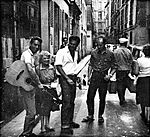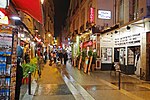Fontaine Saint-Michel
Buildings and structures in the 5th arrondissement of ParisFountains in ParisMonuments historiques of Paris

The Fontaine Saint-Michel (French pronunciation: [fɔ̃.tɛn sɛ̃.mi.ʃɛl]) is a monumental fountain located in Place Saint-Michel in the 6th arrondissement in Paris. It was constructed in 1858–1860 during the French Second Empire by the architect Gabriel Davioud. It has been listed since 1926 as a monument historique by the French Ministry of Culture.
Excerpt from the Wikipedia article Fontaine Saint-Michel (License: CC BY-SA 3.0, Authors, Images).Fontaine Saint-Michel
Place Saint-Michel, Paris 6th Arrondissement (Paris)
Geographical coordinates (GPS) Address External links Nearby Places Show on map
Geographical coordinates (GPS)
| Latitude | Longitude |
|---|---|
| N 48.853144444444 ° | E 2.3437 ° |
Address
Fontaine Saint-Michel
Place Saint-Michel
75006 Paris, 6th Arrondissement (Paris)
Ile-de-France, France
Open on Google Maps









